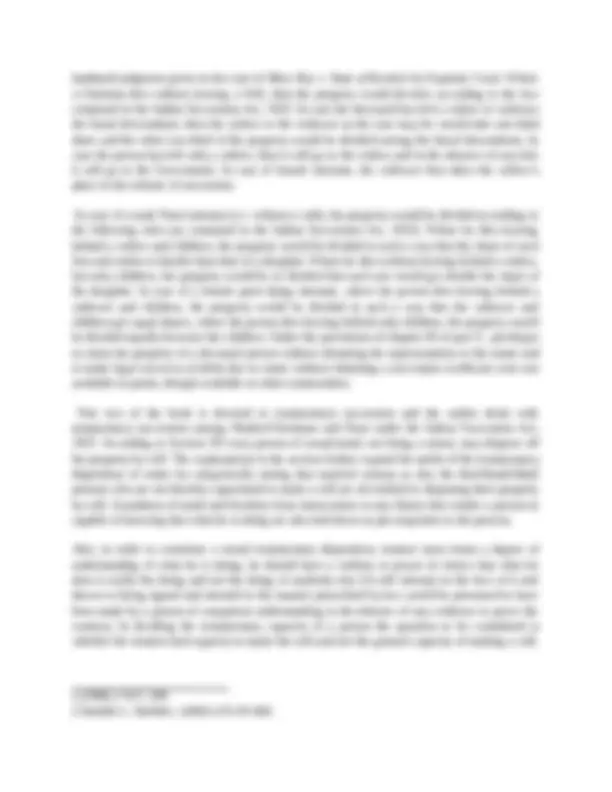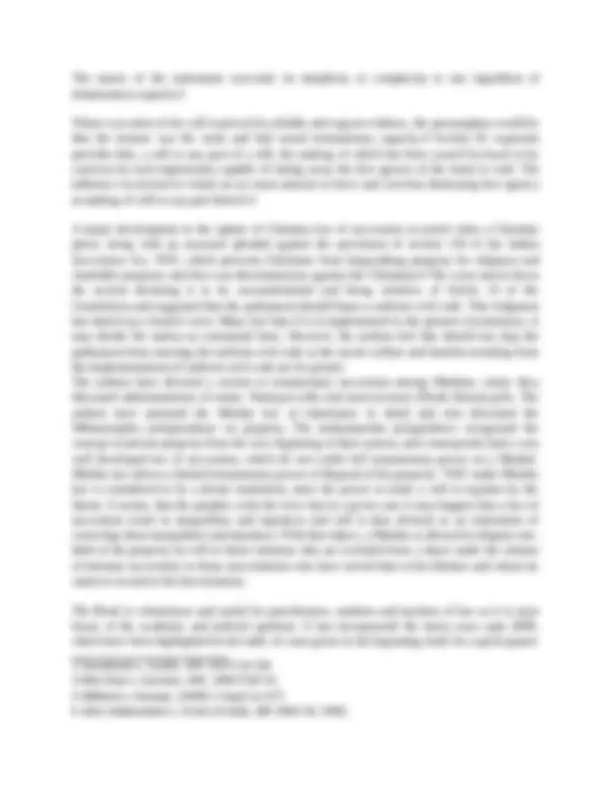





Study with the several resources on Docsity

Earn points by helping other students or get them with a premium plan


Prepare for your exams
Study with the several resources on Docsity

Earn points to download
Earn points by helping other students or get them with a premium plan
Community
Ask the community for help and clear up your study doubts
Discover the best universities in your country according to Docsity users
Free resources
Download our free guides on studying techniques, anxiety management strategies, and thesis advice from Docsity tutors
PARAS DIWAN AND PIYUSHI DIWAN'S MODERN HINDU LAW EDITION 2013
Typology: Study Guides, Projects, Research
1 / 5

This page cannot be seen from the preview
Don't miss anything!




Law of intestate and testamentary Succession (2006). By Paras Diwan, Shailendra Jain and Piyushi Diwan. Universal Law Publishing Co. Pvt. Ltd. Delhi Pp cv+ 1075 price. Rs. 850 /-
The law of succession is one of the very important branches of personal laws. Succession is the mode of devolution of property from a man to his immediate heirs after his death and how the property is devolved or distributed depends on the owner of the property. Our society has been patriarchal and women have remained excluded from every walk of life, be it political, social or economic. The initial reforms were aimed at ensuring women’s economic independence, however, cannot be ensure unless she is given the power and access to means of production and power to organize her property relation. The laws dealing with intestate and testamentary succession in India are diverse and distinct and their application depends upon considerations, like the religion of the parties, domicile, community type of marriage etc. There is further divergence in such laws based on consideration like schools and sub schools viz Mitakshara and Dayabhaga schools of Hindu law and Hanafi and Shia schools of Muslim law. Following these considerations, a multiplication of succession laws is operating and applicable in India. The title of the book indicates that propose study is analysis of the law relating to intestate testamentary succession among Indians. However, the book is primarily section- wise commentary on the Hindu succession Act, 1956 and The Indian Succession Act, 1925 with other enactments and provisions as mere supplements. The book has been divided into two parts.
Part one deals with the intestate succession the first section deals with the intestate succession among Hindus under the Hindu Succession Act, 1956 in brief they provide Section wise case comment on the Hindu Succession Act, 1956 a straightforward approach has been followed by the author by giving descriptive analysis on each section of the Hindu Succession Act 1956 along with illustrations and case comments. The author highlights the separate modes of succession provided for male and female intestate and paramount importance given to the constitution of joint Hindu family, i.e. full ownership in the property for Hindu females, general principles of inheritance, special rules relating to dwelling house, etc. There has been significant progress in the development of Hindu law relating to property. Till 1985, a coparcenary did not admit daughters as it members. Only four States which introduced unmarried daughters as coparceners like the sons were Andhra Pradesh (1985), Tamil Nadu (1989), Maharashtra and Karnataka (1994). The latest development in the laws, i.e., the Hindu Succession (Amendment) Act, 2005 is an outcome of the 174 th^ report of the Law Commission of India, which has now made daughter a coparcener irrespective whether she is married or not. A full-fledged right to daughter in the ancestral property has been bestowed by making daughter a coparcener on the same footing as of a son in a Mitakshara coparcenary. The cumulative effect of the Amendment Act of 2005 brought changes in section 6 and 30. The erstwhile section 6 has been completely modified and the new section has been incorporated. This section has also done away with pious obligation of son, grandson and great-grandson to pay the debt of the ancestor. Consequently
Section 30 dealing with testamentary succession has been modified. Further section 23 and 24 has also been deleted. The former dealt with bar on female heir from asking partition of dwelling house, in which she acquired a right, if it was fully occupied by the members of family the latter section dealt with disallowing certain widows from inheriting in case they remarried. The Amendment Act of 2005 is a step forward in the March of laws in obliterating social provisions of laws that was gender discriminatory and achieving the constitutional goal of equality enshrined in Article 14, 15 and 16 of the constitution, but the author feels that it would add to confusion. The authors further deal with the intestate succession among Muslims where they discuss general principles of inheritance and disqualifications from inheritance under Hanafi and Shia schools of Muslim law. Of all the duties that are to be performed as rites to deceased Muslim, perhaps the most important is the distribution of the estate amongst the heirs according to Shariat. Thus, the task is to first determine which of the relatives of the deceased are entitled to inherit and secondly, to determine the quantum of share entitlement of each of the heirs concerned. The Muslim law of inheritance is fundamentally different from all other parallel system of law of inheritance in India in the sense that the doctrine of joint family system - the Crux of the Mitakshara Hindu law, is non-existent in Islamic laws of inheritance. Also the concept of coparcenary property is non-existent as well for whatever a man or women inherits from his ancestors becomes his or her absolute property. The study focuses on the two main broader versions of Muslim law and focuses on one of the version i.e the version pertaining to the Hanafi law and then delves into the position of the Quranic heirs for holders of obligatory shares as defined in the Holy Quran and then focuses on the differential treatment meted out to agnates and cognates. It also deals with the laws of inheritance governing the Shia Muslim in India. The authors have looked at the distinction between the terms ‘inheritance’ and ‘succession’, the origin of Mohammedan laws of inheritance (a superstructure built on the pre-Islamic customary laws of succession Arabia), reforms introduced by the Quran in order to bring the pre-Islamic laws in conformity with Islamic philosophy, divergence of opinion among Shia and Sunni resulting in two different rules of inheritance. They also discussed in detail the general principles of Shia law relating to inheritance, classification of heirs, doctrines of Return-Radd and increase-aul, disqualifications. The three classes of heirs in modern India have been mentioned and also the division made for the purposes of distribution of assets into sharers and residuaries unlike Sunni law, where a third category ‘distant Kindreds’ exists. The shares of various kinds of heirs as laid down in the Quran have been enumerated. In Shia law, all relations who are not sharers take as residuaries. Intestate succession among Christians/parsi/Jews under the Indian succession Act, 1925 is discussed in a separate section. The law of succession applicable to Christians in India is the Indian succession Act, 1925. There are diverse Indian Christian sects and thus, there is diversity of the laws in matter concerning familial relations. Earlier, Christians in the state of Kerala were governed by two different Acts the Cochin Christian Succession Act, 1921, and the Travancore Christian Succession Act, 1916. These two now stand repealed and the Christians now are governed by the general scheme of inheritance under the Indian Succession Act, 1925 after the
The nature of the instrument executed, its simplicity or complexity is one ingredient of testamentary capacity. 3
Where execution of the will is proved by reliable and cogent evidence, the presumption would be that the testator was the same and had sound testamentary capacity. 4 Section 61 expressly provides that, a will or any part of a will, the making of which has been caused by fraud or by coercion by such importunity capable of taking away the free agency of the testor is void. The influence excrecised to vitiate an act must amount to force and coercion destroying free agency in making of will or any part thereof. 5
A major development in the sphere of Christian law of succession occurred when a Christian priest, along with an associate pleaded against the provisions of section 118 of the Indian Succession Act, 1925, which prevents Christians from bequeathing property for religious and charitable purposes and thus was discriminatiory against the Christians. 6 The court struck down the section declaring it to be unconstitutional and being violative of Article 14 of the Constitution and suggested that the parliament should frame a uniform civil code. This Judgment has stirred up a hornet’s nest. Many feel that if it is implemented in the present circumstance, it may divide the nation on communal lines. However, the authors feel this should not stop the parliament from enacting the uniform civil code as the social welfare and benefits resulting from the implementations of uniform civil code are far greater The authors have devoted a section to testamentary succession among Muslims, where they discussed administrations of estate, Wasiyyat-wills and marz-ul-maut (Death illness) gifts. The authors have analysed the Muslim law of inheritance in detail and also discussed the Mohammaden jurisprusdence on property. The mohammedan jurisprudence recognized the concept of private property from the very beginning of their system, and consequently had a very well developed law of succession, which do not confer full testamentary power on a Muslim. Muslim law allows a limited testamentary power of disposal of his property. ‘Will’ under Muslim law is considered to be a divine institution, since the power to make a will is regulate by the Quran. It seems, that the prophet, took the view that in a given case it may happen that a law of succession result in inequalities and injustices and will is thus devised as an instrument of correcting these inequalities and injustices. With that object, a Muslim is allowed to dispose one- third of his property by will to those relations who are excluded from a share under the scheme of intestate succession or those non-relations who have served him in his lifetime and whom he wants to reward at his last moments.
The Book is voluminous and useful for practitioners, students and teachers of law as it is store house of the academic and judicial opinions. It has incorporated the latest cases upto 2006, which have been highlighted in the table of cases given in the beginning itself for a quick glance
3 Saradendu v. Sudhir, AIR 1923 Cal 116 4 Man Kaur v. Gurnam, AIR, 1984 P&H 51. 5 Williams v. George, (1828) 1 Hag Ecc 577. 6 John Vallamattom v. Union of India , AIR 2003 SC 2902.
on the latest legal point. There are some discrepancies noted in the content pages and the main body between chapters and sub- parts, which requires to be corrected. But it seems to be one of the best books on the subject and on the whole the authors deserve rich compliments for his outstanding contribution to family law in the form of this book. The reviewer appreciates the authors and the publishers for bringing out this book at a very reasonable and affordable price.